#states of water
Text
How a cup of water can unlock the secrets of our Universe
"Researchers from Queen Mary University of London have made a discovery that could change our understanding of the universe. In their study published in Science Advances, they reveal, for the first time, that there is a range in which fundamental constants can vary, allowing for the viscosity needed for life processes to occur within and between living cells. This is an important piece of the puzzle in determining where these constants come from and how they impact life as we know it."
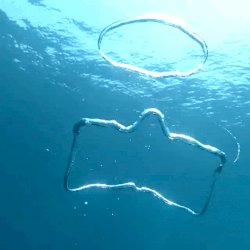
"Fundamental physical constants shape the fabric of the universe we live in. Physical constants are quantities with a value that is generally believed to be both universal in nature and to remain unchanged over time – for example the mass of the electron. They govern nuclear reactions and can lead to the formation of molecular structures essential to life, but their origin is unknown. This research might bring scientists one step closer to determining where these constants come from.
“Understanding how water flows in a cup turns out to be closely related to the grand challenge to figure out fundamental constants. Life processes in and between living cells require motion and it is viscosity that sets the properties of this motion. If fundamental constants change, viscosity would change too impacting life as we know it. For example, if water was as viscous as tar life would not exist in its current form or not exist at all. This applies beyond water, so all life forms using the liquid state to function would be affected.”"
continue reading article
#water#life#universe#physics#mother water#birth#birth and creation#body#nature#earth#ocean#sea#river#electronics#nuclear reactions#structure#motion#states of water#science#discovery
4 notes
·
View notes
Text
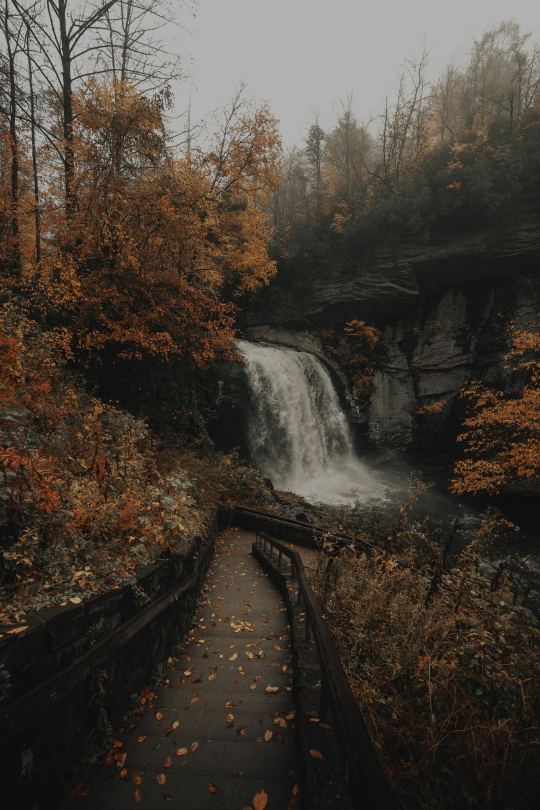
(by Clay Banks)
#vertical#landscape#x#a#watsf#curators on tumblr#water#trees#Clay Banks#waterfall#cliff#fall#autumn#Looking Glass Falls#North Carolina#united states
2K notes
·
View notes
Text
Scientists have developed a new solar-powered system to convert saltwater into fresh drinking water which they say could help reduce dangerous the risk of waterborne diseases like cholera.
Via tests in rural communities, they showed that the process is more than 20% cheaper than traditional methods and can be deployed in rural locations around the globe.
Building on existing processes that convert saline groundwater to freshwater, the researchers from King’s College London, in collaboration with MIT and the Helmholtz Institute for Renewable Energy Systems, created a new system that produced consistent levels of water using solar power, and reported it in a paper published recently in Nature Water.
It works through a process called electrodialysis which separates the salt using a set of specialized membranes that channel salt ions into a stream of brine, leaving the water fresh and drinkable. By flexibly adjusting the voltage and the rate at which salt water flowed through the system, the researchers developed a system that adjusts to variable sunshine while not compromising on the amount of fresh drinking water produced.
Using data first gathered in the village of Chelleru near Hyderabad in India, and then recreating these conditions of the village in New Mexico, the team successfully converted up to 10 cubic meters, or several bathtubs worth of fresh drinking water. This was enough for 3,000 people a day with the process continuing to run regardless of variable solar power caused by cloud coverage and rain.
[Note: Not sure what metric they're using to calculate daily water needs here. Presumably this is drinking water only.]
Dr. Wei He from the Department of Engineering at King’s College London believes the new technology could bring massive benefits to rural communities, not only increasing the supply of drinking water but also bringing health benefits.
“By offering a cheap, eco-friendly alternative that can be operated off the grid, our technology enables communities to tap into alternative water sources (such as deep aquifers or saline water) to address water scarcity and contamination in traditional water supplies,” said He.
“This technology can expand water sources available to communities beyond traditional ones and by providing water from uncontaminated saline sources, may help combat water scarcity or unexpected emergencies when conventional water supplies are disrupted, for example like the recent cholera outbreaks in Zambia.”
In the global rural population, 1.6 billion people face water scarcity, many of whom are reliant on stressed reserves of groundwater lying beneath the Earth’s surface.
However, worldwide 56% of groundwater is saline and unsuitable for consumption. This issue is particularly prevalent in India, where 60% of the land harbors undrinkable saline water. Consequently, there is a pressing need for efficient desalination methods to create fresh drinking water cheaply, and at scale.
Traditional desalination technology has relied either on costly batteries in off-grid systems or a grid system to supply the energy necessary to remove salt from the water. In developing countries’ rural areas, however, grid infrastructure can be unreliable and is largely reliant on fossil fuels...
“By removing the need for a grid system entirely and cutting reliance on battery tech by 92%, our system can provide reliable access to safe drinking water, entirely emission-free, onsite, and at a discount of roughly 22% to the people who need it compared to traditional methods,” He said.
The system also has the potential to be used outside of developing areas, particularly in agriculture where climate change is leading to unstable reserves of fresh water for irrigation.
The team plans to scale up the availability of the technology across India through collaboration with local partners. Beyond this, a team from MIT also plans to create a start-up to commercialize and fund the technology.
“While the US and UK have more stable, diversified grids than most countries, they still rely on fossil fuels. By removing fossil fuels from the equation for energy-hungry sectors like agriculture, we can help accelerate the transition to Net Zero,” He said.
-via Good News Network, April 2, 2024
#water#water scarcity#clean water#saline#desalination#off grid#battery technology#solar power#solar energy#fossil fuels#water shortage#india#hyderabad#new mexico#united states#uk#united kingdom#good news#hope#aquifers
822 notes
·
View notes
Text
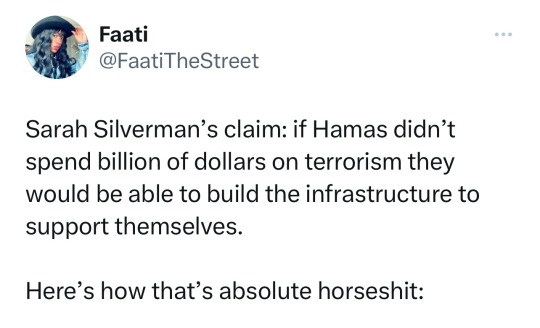
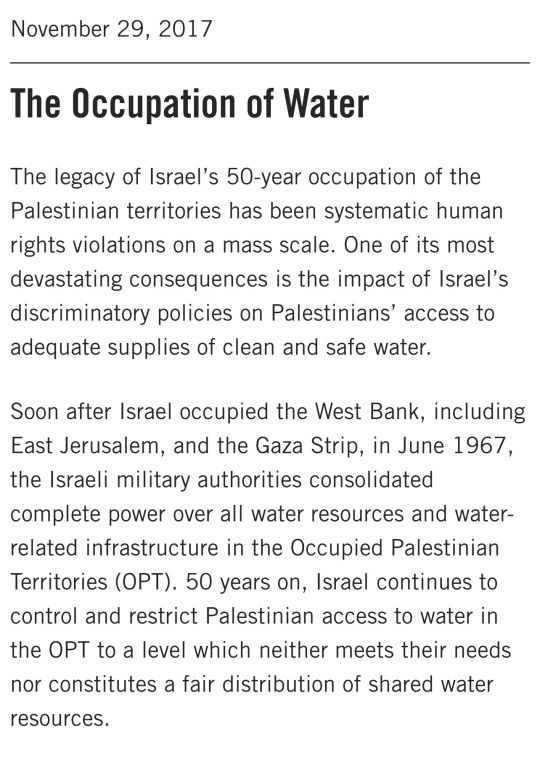
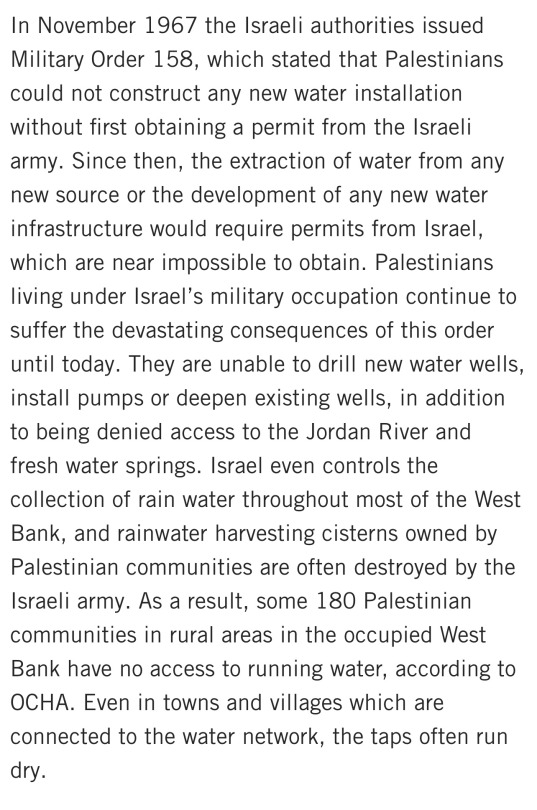
Hamas ≠ Palestine
👉🏿 https://www.amnesty.org/en/latest/campaigns/2017/11/the-occupation-of-water/
👉🏿 https://www.tumblr.com/odinsblog/730635185110073344
#politics#palestine#gaza#israel#sarah silverman#water rights#hamas ≠ palestine#war crimes#israel is an apartheid state#benjamin netanyahu is a war criminal#the occupation of water#military order 158#false media narratives#victim blaming#media propaganda#false narratives
1K notes
·
View notes
Text

#get ready for the weekend#just a friendly reminder to plan accordingly for the en masse travel to states with totality#please give yourselves ample time on the road to get where you’re going#keep snacks and water in the car#and most importantly be smart and be safe#solar eclipse#solar eclipse 2024#bugs bunny#bugs bunny meme
421 notes
·
View notes
Text

#pokemon#pokemon sv#pokemon scarlet and violet#grusha#cetitan#aquanutart#i was like oh the new ice gym leader has such a great design i hope i have a chance to draw her one day#*reads the wiki page* excuse me what. oh i accidentally drew him immediately#he has an adorable round snow whale thing friend what am i supposed to do#anyway thanks pokemon i feel slightly less upset about it being WINTER#I DON'T LIKE WINTER#i prefer water in a liquid not solid state#if it's not at least 70F/21C and sunny it's winter to me#anyway grusha and i would unfortunately live in different worlds because i cant hack these arctic temperatures (= less than aforementioned#IT GETS BELOW FREEZING HERE HELP ME I'M A FROG#i am fine don't worry about me. i am being dramatic. i have survived many winters i am a strong frog#TWO MORE MONTHS#HAPPY NEW YEAR!!!!
494 notes
·
View notes
Video
“ Take a deep breath “ // © Scenic Creek Photography
Music: Peder B. Helland - Early in the Morning
#pennsylvania#United States#nature#landscape#Forest#river#trees#Sunrise#stream#water#4K#8K#fpv#reels#aesthetics#wanderlust#explore#follow#discover
3K notes
·
View notes
Photo

a redraw of ‘lament for icarus’ by herbert james draper ✷
#mine#heheHEHEHE#this was a little tricky to figure out colour wise but i did it!!#orange overlay orange multiply my beloved#also made him trans bc. i can.#DONT look at the rocks too hard okay i. i was tired by that point#and the water also thats meant to be a straight line some how it is diagonal#they are going downhill its fine#owhh today we went to a stately home bc my mum got national trust membership heehe#my god that was a home. i havent been to one like it there was a huge hallway#im talking like. very large. lined w tapestries n paintings#i like. wanna learn how to oil paint low key high key. its not rlly a good time for me to learn that now but....one day#i gotta figure out portraits first hehe#i want to draw. realistic. portraits. bring my gcse art dream to life#i think i can do that. it will just..take time. idk how to learn that skajfbsdjkbs#n also need to find my way of doing it artistic language etc etc#ihg my leggies hurt. lots of walking#im going to play some hollow knight i think then go 2 bed#tomorrow is turning into a house task day it seems. maybe i will also try 2 figure out portrait hehe#i'll add id tomorrow!!
9K notes
·
View notes
Text
"but hamas is getting funded by extremist islamic hate groups!" do you think the U.S. government and military giving funding for israeli's war efforts against palestinians is a morally neutral and inherently righteous body that had no influence in the politics of southwest asia as a global colonial superpower. do you really think anything you can say about the people resisting oppression can't be said about the oppressors.
#brieuc.txt#palestine#this isnt me justifying it but it is me pointing out the double standard how hamas' funding is antithetical to the freedom movement#but the u.s.' influence and financial support is completely fine and doesnt need to be brought up at all#''hamas doesnt have the best interests of palestinian people'' may be true but the alternative is not allowing an apartheid state to exist#also its a ridiculous thing to say because thats a common thing in most countries#neo-nazi groups r a major problem in the Ukraine military but nobody questions ukraine's right for freedom.#the double standards keep on piling up#im not saying you cant criticise these groups but is it criticism or is it propaganda#are you talking abt how war radicalises and changes n traumatises people or are you implying every palestinian is a dirty terrorist#etc#and do you understand that in an active war zone n worlds largest open air prison violence is guaranteed and is brutal.#or do you think that if the people with no electricity and water just Werent So Stubborn And Talked everything would be okay?#and do you consider white people fighting for freedom martyrs but brown people doing the same terrorists
737 notes
·
View notes
Text

Hike in the PNW. @natureisbeautifull
#original photography#photographer on tumblr#nature#pws photos worth seeing#landscape#water#clouds#trees#flora#blue sky#washington state#pnw#hike#outdoors#outdoor adventure
258 notes
·
View notes
Note
To me, Machete kind of has the energy of a secondary villain/coldhearted side character in someone else's story that a lot of fans latch onto, moreso than the protagonist. Question is, would he be the villain in anyone's story?
Why, thank you! I'm actually glad to hear he gives off that vibe. I don't think he set out to become a villain but a lot of people certainly view him as one.
#in the 16th century canon he starts out as an introverted but sincerely well meaning guy that never quite manages to find his social niche#he was a sensitive kid and when subjected to enough pressure#his insecurity fearfulness and powerlessness mutate into distrust resentment aggression suffocating repression and self-restraint#I don't think he's a bad person in fact he consistently tries very hard to do the right thing#do his job properly avoid letting people down and get through life with a sense of dignity#but he is supposed to come across kind of cold impersonable and difficult to be around if you don't know him personally (and very few do)#people can sense there's something wrong with him and are put off by it#Vatican is a nest of vipers and as the stakes rise he retreats deeper into his coldblooded untouchable work persona#he has no choice but to start lying scheming blackmailing and eliminating his enemies#in order to maintain his position keep Vasco safe their relationship under wraps and his own head above water#essentially playing by the same rules everyone else in the holy see has been playing with for centuries#eventually he loses his spot as the secretary of state and is manipulated/forced to take on a role in the roman inquisition#and if people were sort of iffy about him before being the authority overseeing trials torture excommunications and executions doesn't help#and since he has so few allies and such an infamous reputation he's an easy target for scapegoating whenever necessary#towards the end it dawns on him that he's become the kind of twisted cruel corrupt person he used to fear and despise#and the guilt moral injury and abject self-loathing had largely sapped him of his will to live by the time the final assassin gets him#answered#anonymous#Machete#Vaschete lore#he thought his dream of priesthood would make him a better person more worthy of admiration safety and love but he climbed too high#and got roped up in the dangerous games that take place under god's nose and slowly got strangled to death
359 notes
·
View notes
Link
“A new kind of "phase transition" in water was first proposed 30 years ago in a study by researchers from Boston University. Because the transition has been predicted to occur at supercooled conditions, however, confirming its existence has been a challenge. That's because at these low temperatures, water really does not want to be a liquid, instead it wants to rapidly become ice. Because of its hidden status, much is still unknown about this liquid-liquid phase transition, unlike the everyday examples of phase transitions in water between a solid or vapor phase and a liquid phase.”
“The team has used computer simulations to help explain what features distinguish the two liquids at the microscopic level. They found that the water molecules in the high-density liquid form arrangements that are considered to be "topologically complex," such as a trefoil knot (think of the molecules arranged in such a way that they resemble a pretzel) or a Hopf link (think of two links in a steel chain). The molecules in the high-density liquid are thus said to be entangled.
In contrast, the molecules in the low-density liquid mostly form simple rings, and hence the molecules in the low-density liquid are unentangled.
Andreas Neophytou, a Ph.D. student at the University of Birmingham with Dr. Dwaipayan Chakrabarti, is lead author on the paper. He says, "This insight has provided us with a completely fresh take on what is now a 30-year old research problem, and will hopefully be just the beginning."
continue reading
#water#physics#phase transition#states of matter#states of water#fluid dynamics#energy#temperature#density#entanglement#microcosm#colloidal#hydrogen network#energy field#science#discovery
8 notes
·
View notes
Text

(by Daniel Salcius)
#vertical#landscape#x#a#watsf#curators on tumblr#water#ocean#Daniel Salcius#Laguna Beach#california#united states#sunset
1K notes
·
View notes
Text
"Namibia is the driest country in Sub-Saharan Africa, and home to two of the world’s most ancient deserts, the Kalahari and the Namib. The capital, Windhoek, is sandwiched between them, 400 miles away from the nearest perennial river and more than 300 miles away from the coast. Water is in short supply.
It’s hard to imagine life thriving in Windhoek, yet 477,000 people call it home, and 99 per cent of them have access to drinking water thanks to technology pioneered 55 years ago on the outskirts of the city. Now, some of the world’s biggest cities are embracing this technology as they adapt to the harshest impacts of climate change. But Namibia leads the way.
How did this come about? In the 1950s, Windhoek’s natural resources struggled to cope with a rapidly growing population, and severe water shortages gripped the city. But disaster forced innovation, and in 1968 the Goreangab Water Reclamation Plant in Windhoek became the first place in the world to produce drinking water directly from sewage, a process known as direct potable reuse (DPR).
That may sound revolting, but it’s completely safe. Dr Lucas van Vuuren, who was among those who pioneered Windhoek’s reclamation system, once said that “water should not be judged by its history, but by its quality”. And DPR ensures quality.
This is done using a continuous multi-barrier treatment devised in Windhoek during eight years of pilot studies in the 1960s. This process – which has been upgraded four times since 1968 – eliminates pollutants and safeguards against pathogens by harnessing bacteria to digest the human waste and remove it from the water. This partly mimics what happens when water is recycled in nature, but Windhoek does it all in under 24 hours...
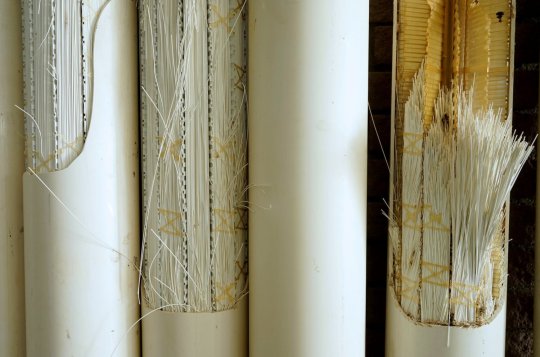
Pictured: These ultrafiltration membranes help to remove bacteria, viruses and pathogens. Image: Margaret Courtney-Clarke
“We know that we have antibiotics in the water, preservatives from cosmetics, anti-corrosion prevention chemicals from the dishwasher,” Honer explains. “We find them and we remove them.”
Honer adds that online instruments monitor the water continuously, and staff ensure that only drinking water that meets World Health Organisation (WHO) guidelines is sent to homes. If any inconsistencies are detected, the plant goes into recycle mode and distribution is halted until correct values are restored.
“The most important rule is, and was, and always will be ‘safety first’,” says Honer. The facility has never been linked to an outbreak of waterborne disease, and now produces up to 5.5m gallons of drinking water every day – up to 35 per cent of the city’s consumption.
Namibians couldn’t survive without it, and as water shortages grip the planet, Windhoek’s insights and experience are more important than ever.
Interest from superpowers across the globe
In recent years, delegations from the US, France, Germany, India, Australia, Singapore, and the United Arab Emirates have visited Windhoek seeking solutions to water shortages in their own countries.
Megadrought conditions have gripped the US since 2001, and the Colorado River – which provides 40 million people with drinking water – has been running at just 50 per cent of its traditional flow. As a result, several states including Texas, California, Arizona and Colorado are beginning to embrace DPR.
Troy Walker is a water reuse practice leader at Hazen and Sawyer, an environmental engineering firm helping Arizona to develop its DPR regulations. He visited Windhoek last year. “It was about being able to see the success of their system, and then looking at some of the technical details and how that might look in a US facility or an Australian facility,” he said. “[Windhoek] has helped drive a lot of discussion in industry. [Innovation] doesn’t all have to come out of California or Texas.”

Pictured: The internal pipes and workings of Namibia's DPR plant. As water becomes scarcer in some parts, countries are looking to DPR for solutions. Image: Margaret Courtney-Clarke
Namibia has also helped overcome the biggest obstacle to DPR – public acceptance. Disgust is a powerful emotion, and sensationalist ‘toilet to tap’ headlines have dismantled support for water reuse projects in the past. Unfortunately, DPR’s biggest strength is also its biggest weakness, as the speed at which water can re-enter the system makes it especially vulnerable to prejudice, causing regulators to hesitate. “Technology has never been the reason why these projects don’t get built – it’s always public or political opposition,” says Patsy Tennyson, vice president of Katz and Associates, an American firm that specialises in public outreach and communications.
That’s why just a handful of facilities worldwide are currently doing DPR, with Windhoek standing alongside smaller schemes in the Philippines, South Africa and a hybrid facility in Big Spring, Texas. But that’s all changing. Drought and increased water scarcity worldwide are forcing us to change the way we think about water.
Now, the US is ready to take the plunge, and in 2025, El Paso Water will begin operating the first ‘direct to distribution’ DPR facility in North America, turning up to 10m gallons of wasterwater per day into purified drinking water – twice as much as Windhoek. San Diego, Los Angeles, California, as well as Phoenix, Arizona are also exploring the technology."
Of course, DPR is not a silver bullet in the fight against climate change. It cannot create water out of thin air, and it will not facilitate endless growth. But it does help cities become more climate resilient by reducing their reliance on natural sources, such as the Colorado River.
As other nations follow in Namibia’s footsteps, Windhoek may no longer take the lead after almost six decades in front.
“But Windhoek was the first,” Honer reminds me. “No one can take that away.”"
-via Positive.News, August 30, 2023
#namibia#africa#desert#water shortage#water conservation#dpr#potable water#water recycling#clean water#drought#united states#colorado river#science and technology#sanitation#good news#hope
2K notes
·
View notes
Text

It feels good to be back.
(A more risque version under the cut)

#Percico#PJO#Percy Jackson#Nico Di Angelo#it wasn't meant to show so much navel but as I kept correcting their arms Percy's kept going down -they were too damn short-#i hate having to state this but just in case it's not obvious enough no minors are depicted here#Nico has been aged up -and I tried to give Percy like 23-ish but I think I failed at that-#Also about the concept? There is no concept#I wish i could give you a cool one but this time I just wanted them to ovreflow with intimidating power couple vibes tbh#give them the story you want#it could be a twisted merman AU or a canon divergence where Nico actively goes after Percy idk#“Black Water” maybe?#Nicercy#Pernico
196 notes
·
View notes
Text
Damian landed with a small thud in the alleyway, standing up and walking forward while unsheathing his blade. It drew an elegant arc in the air, before it tips was placed at another's throat, forcing them to tilt their head upwards to avoid injury. "What do you think you are doing here?"
Eyes were peeled open slowly, and the wheezy that filled the alleyway took on a more amused edge. "I don't know, why do you think I'm here," Danny tried to tilt his head, before stopping with a wince and a sharp intake. "Can't I just visit my big bro, from time to time?"
Damian tilted his head slightly, eyes roaming over the various wounds over his brother's body and the amount of ectoplasm on the ground around him, before leaving Danny with the most unimpressed look he could make. Danny chuckled wetly, before devolving into a coughing fit, then smiling wryly. "Heh, ya got me I guess."
"Tt." Damian lowered his blade, enough for Danny to no longer have to strain his head upwards. "What brought you to this state, Daniel? Those inventors you keep around are certainly brilliant, but incompetent." Damian's eyes narrowed. "So who."
"Yea, wasn't them. Can't really do that when you're blown to smitheries, right?" Danny chuckled humorlessly, before falling silent with a pained wheeze. His head threatened to fall downwards, and his eyelids drooped. A slight press against his neck snapped him back into the waking world. "Right, right. Okay so, would you believe me if I said that a," Danny swallowed. "A government branch is currently chasing me after they found out about my half-dead status?"
Damian stared silently, then sighed. "I'm not surprised, you always were an idiot." Danny puffed up his cheeks indignantly. "Hey! It wasn't my fault this time!"
"Whatever you say, Daniel." Damian pressed the tip of his sword further against Danny's throat. "That still does not explain why you came here, of all places."
"Amity Park's compromised for me, and well." Danny gave a half shrug, or at least tried too before wincing. "This is one of the last places they would look, and I'm too," Danny gesture to himself. "You know, to go for another fly."
Damian nodded. "I can see that." Damian dissected Danny with his eyes, taking in his injuries, his ruined outfit, the blood running down his face over one of his eyes.
Hm.
Damian let out an annoyed sigh, before twirling his sword away from Danny's neck and putting it back into its sheathe. He lifted the edge of his cape. "Get in before I regret this."
Danny blinked in surprised confusion. "What?"
Damian scowled. "Get. In." He flapped the edge of his cape for emphasis, and Danny blinked again, before suddenly being hit with a wave of understanding. "Oh, oh! Really?"
"I will not be repeating myself for a third time."
"Aw! I knew you cared about me!" Danny flew into Damian's cape, leaving a trail of ectoplasm behind in his flight that was quickly taken hold of by gravity and splattered against the ground.
Damian pulled a face, because he already felt like he regretted doing this.
"Robin, where are you?" His father's voice coming from his comm snapped him from his regret. He jumped onto a nearby pipe and flipped himself up onto one of the buildings, gritting his teeth in annoyance as Danny clapped with his cape. He glanced back at the alleyway, before turning.
"On my way, father." And just like that, he was out into the night with one extra (annoying) passenger.
#dc x dp#dp x dc#dp x dc crossover#dpxdc#dcxdp#danny and damian are twins#Just stating this here that Lazarus Water and Ectoplasm isn't the same thing in this au#Teehee#Edit: Don't mind me rereading this and editing it lmao
962 notes
·
View notes